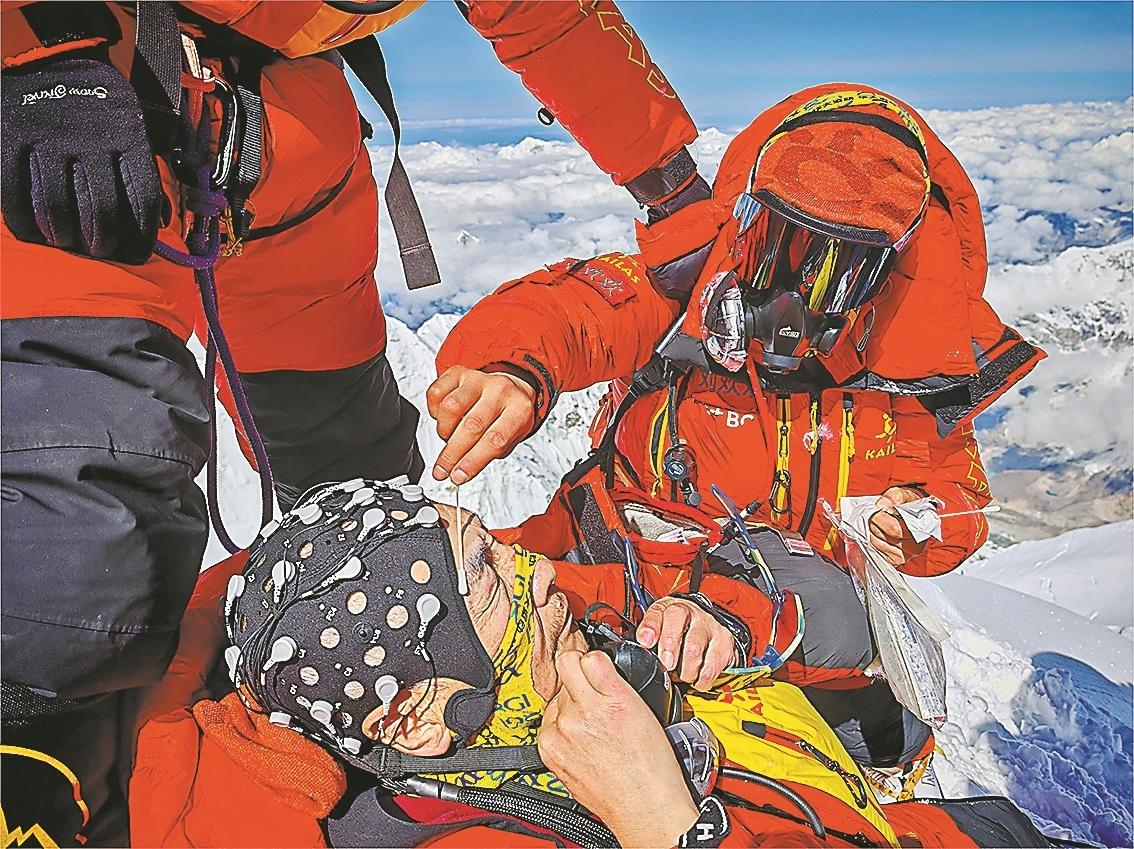
Lin Yuan, full media reporter of Yangcheng Evening News
At 10:28 on May 21, Wang Jian, the co-founder and chairman of Huada Group, led the Linghua Mountain Climbing Team to successfully climb Mount Everest from the north slope, and returned the world's first ultrasound image and EEG data from the top of the world. This is also the second time that 70 year old Wang Jian has climbed to the top of Mount Everest, setting a new record for the oldest person to climb Mount Everest in China.
The purpose of climbing Mount Everest is scientific exploration, which aims to create high-altitude scientific research data, deeply analyze the adaptive physiological mechanism of human body in high-altitude areas, and bring new breakthroughs and inspiration for future scientific and industrial development.
Helping to build a large model of human health and life at high altitude
On April 18 this year, the Huada mountaineering team arrived at the Everest Base Camp in Shigatse, officially launching the Everest research plan. In the process of altitude adaptation training and climbing, Huada mountaineers continuously monitored and collected multi-dimensional phenotypic data such as physiological indicators, brain cognition, eye movement, fundus, motor function, heart and lung ultrasound of core team members at different altitudes from 0 meters to 8848 meters, and obtained genome, proteome, metabolome, image group, and cell group data.
Relying on the core tools independently developed by Huada and the achievements in brain science, ophthalmology, plateau medicine, sports medicine and other fields, Huada will use the data obtained from this scientific research plan to help build a large model of human health and life at plateau. According to Wang Jian, "In 2010, we found the plateau adaptive gene EPAS1 based on the life center principle; This time, we turned to the laws of time and space, hoping to further deepen the understanding of genetic and environmental synergy from the dimensions of time and space. "
In order to better complete the scientific research plan of Everest, Huada deployed a series of self-developed "black technologies" in the Everest Laboratory at an altitude of 5200 meters to respond to testing needs and scientific research tasks in a timely manner.
Many "hard core" devices, such as BGI Intelligent Gene Sequencer DNBSEQ-G99, DNBSEQ-E25, and wireless handheld ultrasound, have completed high altitude performance verification in the "Everest Laboratory". These devices can provide powerful tool support for multi group research in extreme environments such as high altitude in the future, and help the development of plateau environmental monitoring and plateau medicine.
Among them, BGI Smart Manufacturing wireless handheld ultrasound has its own remote consultation function. At the camp with an altitude of 8300 meters, Huada mountaineers used the equipment to complete the connection with the head of the ultrasound department of Beijing Hospital 4000 kilometers away, Sichuan Aba clinician 2500 kilometers away, and the Shenzhen team 4000 kilometers away, successfully achieved consultation, and conducted real-time ultrasound scanning of carotid arteries for the mountaineers, To explore the influence of carotid hemodynamics in extremely high altitude areas.
It is worth mentioning that BGI Smart Manufacturing wireless handheld ultrasound also accompanied the team to the summit of Mount Everest, and obtained real-time carotid ultrasound scanning images of the team members at the summit, which is also the world's first ultrasound image born on the top of the world. It is also exciting that the resting EEG data of mountaineers were recorded for the first time at the top of the world.
Exploring the physiological mechanism of human beings under extreme conditions
In May 2010, Wang Jian and others climbed Mount Everest from the south slope. In that year, the scientific research team of Huada revealed the secret of human adaptation to plateau environment - mutation of EPAS1 gene. This study clarifies the adaptive selection of human genome in extreme environments, and provides a new direction for the prediction, prevention and treatment of high-altitude hypoxia diseases.
In 2021, Wang Jian and others went down to the Mariana Trench with the "Endeavor" submersible for scientific research, opening a new window for marine scientific exploration with gene technology, and accelerating the process of exploring the origin of life and solving the mystery of life.
In the recent year, the Huada mountaineering team has successively completed the climbing of five snow mountains with different elevations, and successfully collected the scientific research data related to Mount Siguniang with an altitude of 5025 meters, Mount Yuzhu with an altitude of 6178 meters, Mount Mustag with an altitude of 7546 meters, Mount Zhuoyou with an altitude of 8201 meters, and Mount Everest with an altitude of 8848 meters A series of studies were carried out on the changes of blood multigroup, skin microorganism, flora adaptability and altitude sickness.
For the objectives of this Huada Everest scientific research plan, Wang Jian said: "We have organized an interdisciplinary team to move more instruments and equipment to higher altitudes, discuss scientific issues such as human physiological mechanism under extreme conditions, and hope to put forward constructive suggestions on important issues such as the origin of life, species evolution, climate change, extraterrestrial life, and make contributions to future scientific development."
Edited by: Wu Jiahong

